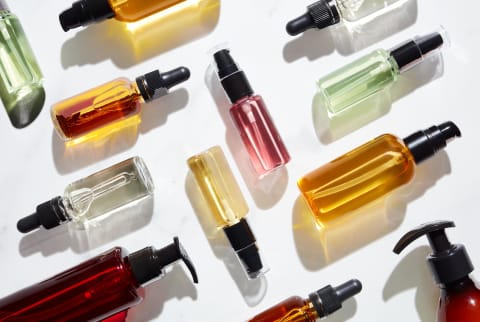Advertisement
These Are The Most Important Essential Oils To Buy Organic


Essential oils are a $3.36 billion industry—and chances are you have a couple of those dark amber bottles in your bathroom cabinet ready to be used as a DIY beauty ingredient or first-aid remedy (tea tree is super antimicrobial, FYI), or in your living room next to your essential oil diffuser. You probably feel pretty good about it, too—after all, these are potent natural plant extracts—but have you ever thought about how much pesticide residue they might contain? Since these oils are so potent and concentrated (it takes 63 pounds of lemon balm to make just 5 ml of lemon balm essential oil) wouldn’t it make sense that their pesticide load would also be pretty hefty?
As a person who tries to buy organic produce and natural skin care products, this is one of those questions that’s always been lingering in the back of my mind. And I decided to finally reach out to some experts for answers to find out if I’m actually mega-dosing myself with chemicals every time I add a nonorganic EO to my diffuser. The answer, I soon learned: It’s complicated.
Pesticide residue in essential oils may largely depend on the scent.
With many essential oils, you probably don’t have much to worry about in terms of pesticide contamination—even if the plants were sprayed.
Turns out most essential oils are produced through a process called steam distillation, which does a pretty great job of separating the essential oil from plant material and everything else, including pesticide residue. During the process1, plants such as lavender or peppermint are placed inside a metal still where steam breaks them down, causing their tiny volatile compounds to rise up into another part of the still via water vapor. There, the steam condenses into liquid and the essential oils eventually separate from the water molecules. Then the oils are siphoned off and eventually bottled and sold.
“These oils have such a tiny molecular structure—that’s why distillation works so well and takes only essential oils out of the plant material, leaving nearly everything else behind,” says Kathi Keville, director of the American Herb Association and author of Aromatherapy: A Complete Guide to the Healing Art.
But this isn't the case with most citrus essential oils (e.g. tangerine, lemon, bergamot, sweet orange, grapefruit, and lime). Not only is citrus commonly sprayed2 with pesticides, these fruits are transformed into essential oils via a cold-pressing process. With cold-pressing, the rind is essentially just squeezed to remove the volatile oils.
“Contamination is definitely a concern because there is no process of adequately removing the pesticides from the rind, and there’s no separation of the oil,” says Mariza Snyder, D.C., functional wellness practitioner and author of The Essential Oils Hormone Solution. In fact, a 2015 research analysis3 looking at the pesticide residues of nearly 30 different essential oils found that cold-pressed citrus oils were much more likely to contain pesticide residue (in some cases exceeding levels deemed safe) than steam-distilled oils.
So should you always buy organic citrus oils? “Oils are lipophilic, which means they’re going to get into the tissues really fast,” says Snyder. “We’re living in a time when we really don’t need more toxicity, so citrus oils definitely need to be tested for purity, or at least made with organic plants to be using them on a day-to-day basis.”
Organic is good, but it doesn’t necessarily go far enough.
One important point that Keville and Snyder both emphasized: While seeking out a certified organic label may be the simplest way to find a pesticide-free citrus essential oil, it doesn’t necessarily guarantee top quality across the board (in terms of aromatic and therapeutic properties) or that an oil wasn’t adulterated in some way—even if it does contain all organic components.
According to Snyder, mislabeling essential oils (e.g. selling a cheaper oil like lavandin disguised as a more expensive lavender) and diluting essential oils with cheaper carrier oils is a relatively common practice in the industry. That’s why it’s important to not only consider organic growing practices, but to go a step further and seek out essential oils from reputable companies that are transparent with their sourcing and production methods, and that ideally perform third-party lab testing for purity to ensure not pesticides, herbicides, or heavy metals are present.
“There’s no governing body for essential oils, just like there’s no governing body for supplements—so it’s really up to the companies to practice their own due diligence,” says Snyder. A few indicators that a company is doing things right: They have a good reputation, they make it clear on their website where they are sourcing their oils, they are at least performing gas chromatography and mass spectrometry (GC/MS) lab testing, and they readily provide lab test results if you ask.
Bottom line: Organic growing practices may be of particular importance when it comes to finding quality citrus essential oils. But in general you need to consider a number of other factors to ensure you're getting the best possible product.